Text
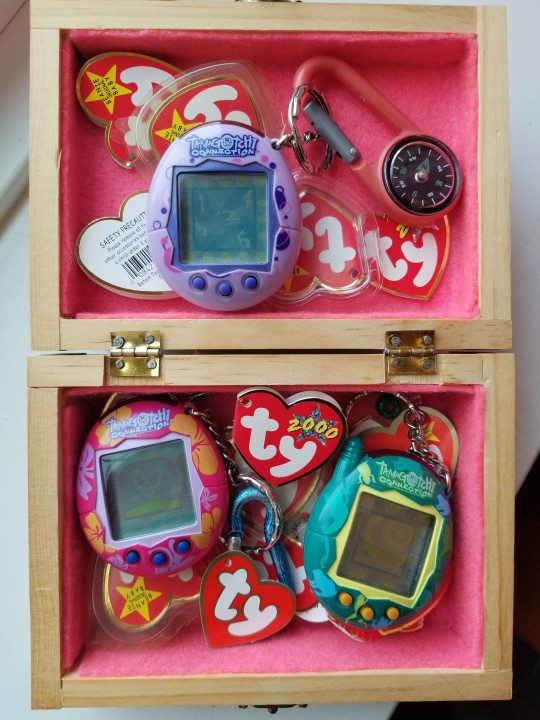
yeah that's probably art.jpeg
#time capsule from the 2000s#collection of things everyone was obsessed with and are no virtually vanished#my nonsense#tamagotchi#beanie babies#and a COMPASS for good measure lol
24 notes
·
View notes
Text
@dannybagpipesarecalling replied to your text post:
I didn't realize those were Destiny's diaries either. If you would be so kind, can you explain how Emma knows? Unfortunately I haven't read enough comics to know this backstory.
I am glad you asked about this, because it gives me an excuse to post about it while hopefully not sounding like a conspiracy blog. I've been slightly obsessed with this idea since Emma first turned up in House of X, so I'm rather excited that “maybe Destiny's Diaries still exist” isn't just my weird crack canon any longer.
Emma was, in short, the last person who can be established to have control over the whereabouts of the diaries. And as one of the top five telepaths in the world, who has expressly defended that secret from the likes of Exodus and Mr. Sinister, she is capable of preventing Professor X from just taking the information from her. So barring new retcons, if Moira has the diaries now, they had to have been obtained directly from Emma.
That's not enough to say that she turned them over to Moira specifically. She could have given them to Charles or Er—okay, no, she wouldn't give them to Charles. There could be a circumstance where she'd trust them to Erik though. But in that contingency, I think there's enough context to support Emma knowing why they'd want them and for who. To be clear though, I would be less confident about making that assertion if Emma hadn't just opened the “Dr. Moira MacTaggert Memorial Public Hospital” expressly to freak out Charles and Erik, and if HoxPox hadn't already linked them by showing Moira to be worried about what Emma was up to.
(This got kind of long so I thought it'd be helpful to say the important part up front before spiraling down the continuity rabbit hole)
The origins and resulting chain of custody for Destiny's Diaries are as follows: One January, decades ago, Destiny began recording visions of the future in a series of diaries. Filling one book per month, she continued writing for thirteen months. This process was described as auto-writing, and Destiny herself did not have a complete memory of what she had written, nor did she understand the meaning of much of what she wrote.
Nonetheless, the July diary contained a recording of the events leading up to the defeat of Apocalypse, and another diary contained information on the life of Hope Summers, so they've been very relevant to the events of the modern era. It's not explicit yet that Krakoa's founding is also in the diaries, but because we know Destiny had at least one separate vision of Krakoa, and because Moira is interested in reading them, it seems fairly likely that whatever Moira, Charles, and Erik have been doing behind the scenes is also in there.
In the decades since Destiny authored them, most of these diaries were lost, except for five that Mystique kept hold of, and a sixth that Irene hid away herself. After Mystique killed 'Moira,' she sent her five diaries to Professor X, hoping that the temptation of using them would consume his life and lead him toward a ruinous fate. Destiny meanwhile had entrusted the sixth diary to Shadowcat (who Destiny met in 1936, while she was time traveling and having an affair with Moira's grandfather don't worry about it), who eventually became so freaked out by something she read in it that she vanished on a mission, let her friends believe her dead for weeks, and had herself deleted from Cerebro, while leaving the diary to Rogue for safekeeping while she was away.
(That last chain of events isn't incredibly important, I just think it becomes kind of lol in light of current canon)
Rogue went on to take that diary and the research that had been done on it to Storm. Storm and Rogue then formed a splinter team of X-Men, to journey the world searching for the lost diaries, believing Professor X could not be trusted. Along the way a seventh book turned up with a treasure hunter named Vargas (don't worry about him), and an eighth was found by Gateway and given to Rogue in a dream. Eventually Storm tried to get Phoenix to collect Professor X's diaries for her, but they discovered that they had already been stolen (Shadowcat did it).
The rest of the diary hunt isn't really important, just that Kitty eventually ended up retrieving the full set, before she rejoined the X-Men, which only happened after Xavier had left Scott and Emma to run the school. This timeline is important for establishing that Xavier has never possessed the full set of diaries himself, and was not involved in collecting the lost books at any point, nor was he present at the time the diaries were brought to the school and fell under Emma's protection. This rules out the possibility that the set of diaries we've previously seen were somehow forged by Xavier.
Xavier would not return to the school until after losing his mutant powers, whereupon he departed for space on an adventure to another galaxy. He was unavailable, therefore, to have undertaken any telepathic shenanigans, so what happens next actually happened, and is not a psychic illusion. While Xavier was gone, Mr. Sinister recruited Exodus and Mystique, and began a campaign of hunting down precognitive psychics, time travelers, and any other sources of information on the future. Scott, Emma, and Kitty meanwhile predicted that they were going to be next, and came up with a bananas plan to keep the books safe.

X-Men volume 2 no. 203 by Mike Carey (Writer), Humberto Ramos (Penciler), Carlos Cuevas (Inker), Studio F’s Edgar Delgado (Colorist), Virtual Calligraphy’s Cory Petit (Letterer), Will Panzo (Assistant Editor), Nick Lowe (Editor), Joe Quesada (Editor in Chief), Dan Buckley (Publisher)
First they hid the diaries somewhere in parts unknown. Emma then altered the minds of “all of us” (everyone who lived at the mansion at that time) to perceive a bunch of decoy books as the real thing. She then erased Kitty's memory, and her own, so that no telepath would be able to extract the information by force, before they gave each other a series of post-hypnotic triggers so they could restore one another's memories if they ever needed the books again. When eventually Exodus attacked the school looking for the books, they restored their memories, and decided to send another team to the hidden location where they'd buried a mystery box. Emma gave this location to Sam and Bobby, who dug up the box, which was never opened, and which was destroyed by Gambit during a firefight with Sinister's forces before anyone could confirm its contents.
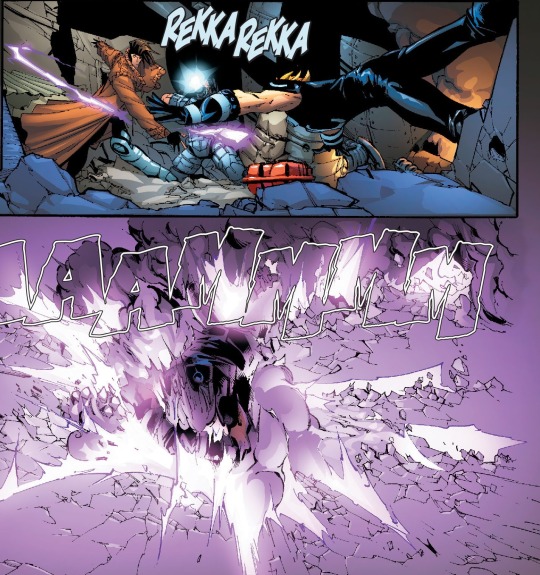
This was intended by author Mike Carey to be the end of Destiny's Diaries, a dropped plot from a previous creative run, that was vaguely useful at building up to the Messiah Complex crossover, but was a lot more trouble than it was worth to an author who was writing about the X-Men trying to avert a bad future. But there's a lot of room in the story he wrote for the diaries to have survived after all.
I think it's actually really suspicious that the box was accessible to Bobby and Sam at all. Why not drop it under a mountain? Why not bury it under the ocean? Why not keep it phased in a tree? And it's a big red box with a big red 'X' on it. I know the X-Men love their branding and all, but that's going pretty far.
No one actually opens the box before Gambit blows it up either. It could have contained more decoys, or nothing at all.
And when talking among themselves, Emma and Kitty never actually say that they're sending the X-Men to retrieve the diaries. They say that they know where the diaries are, and then send the X-Men to a place where they've buried something. The intent of the author is clear, but there's room in the dialogue for a later writer to decide that this just was another plan to keep the books hidden.
So for the entire period of time between assembling the complete collection of thirteen diaries, and their seeming destruction, they are never unaccounted for. Only Emma and Kitty knew the full extent of what they did to hide them, and where they were hidden. If fakes were destroyed instead of the real thing, no one would have known.
We could just be in retcon territory, but I don't think so, because it's fine on its own without any direct changes to canon. And really, faking the destruction of the books to cover up their real location makes a lot more sense than believing Emma Frost actually sent Sam to retrieve the incredibly suspicious looking red box that contained the most important object in the world, while half the super villains on the planet were chasing him.
Believing the diaries weren't really destroyed just requires the reader to accept that Emma would lie to the other X-Men, and keep lying to them for years, and that she'd be willing to put Sam and Bobby's lives at risk to protect that lie. Which she was already doing in that story anyway. She was already lying to everyone when she changed everyone's memories. And she—and Scott and Kitty—was already fine with risking everyone's lives when setting up a decoy trap in a school. So that's why I think this works better as a continuation of the existing, known, story of the diaries, and not a direct retcon to what happened.
In conclusion I think Emma knows about Moira because Moira got the diaries from somewhere, and Emma is the person she could have gotten them from. Nothing proves a direct hand-off in, like, a formal standard of proof or anything, but Emma having access to the diaries for so long, and having been wrapped up in this whole weird plot thread—which involves Moira and most of the Quiet Council—is enough to imply the connection in a story sense.
(ETA - For completion’s sake, there is also a weird story I didn’t go into called Chaos War that was published in 2011 where Moira is resurrected and finds a book in the ruins of the Xavier School that may or may not be one of the diaries, and touching it causes her soul to merge with Destiny’s, who then possesses her and guides her through a quest to destroy an evil god. This was an odd story to place in continuity at the time, and has only gotten stranger, given 1. that couldn’t be the real Moira, 2. Destiny is not merged with her soul. If this is in continuity (it’s been suggested that Moira’s golem was the character in this event), and all of the characters are who they say they are, and if the book in question was actually one of the thirteen diaries (and not some other book that Irene also wrote), then it requires Emma to have deliberately left one of the thirteen books behind for “Moira” to find, which if anything only adds to the likelihood that she knows what’s up)
22 notes
·
View notes
Text
Why You Should Be Shipping Shigaraki/Ochako
No, no, hang on a second--I see that side-eye you are throwing hard enough to ruin your peripheral vision. I feel the shade you’re casting like a thundercloud rolling in. But you didn’t read wrong. I meant what I said.
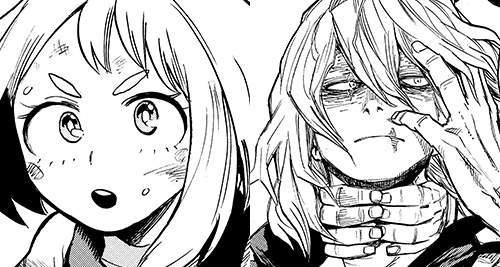
I’ve never made a secret of my love for rare pairs, but for once in my damn lonely shipper’s hellscape of a life I would love it if my favorite crack ship in a fandom had more than two fics (I’m NOT JOKING) to its name.
What can I do to correct this egregious oversight before the entire summer passes with nary a whisper of the most romantic ship since Juliet wherefore art thou’d Romeo?
Well, what else? I was forged in the fires of early 2000s’ fandom, and I know that desperate times call for desperate measures meticulously researched and extremely rose-tinted
Shipping Manifestos.
Fam, I am about to blow your minds, align your chakras, open your third eyes--because Shigaraki and Ochako is the most slept on ship in the entire BNHA fandom, and if you give me ten minutes like an hour (holy shit, this is long), I can prove it.
Disclaimer: @mistystarshine is the enabler who convinced me to write this but we were both enabled by @ohmytheon’s Reconfigure (on AO3) so you know who’s really responsible.
Spoilers to Chapter 231, watch out.
First off, I know what you’re thinking. Maybe you’re still reading from pure shock. Maybe you’re doubt-reading to get your daily fix of internet skepticism. Maybe you’re waiting for me to say these two characters are meant to be because she wears pink and his hair is blue. Maybe you’re already freaking out about age gaps but like that is what future fics and AUs are actually for!!!
I’m not telling you to give up your IzuOcha or Kacchako. I’m not gonna pry ShigaDabi out of your eager little villain stan hands. But if you’ve never considered multi-shipping, now is the time my friends, because I’m totally serious heartfelt here! I’ve got VALID reasons for shipping Shigako--ten of them, in fact:
1) Midoriya is taken for granted as Uraraka’s love interest--but Shigaraki is incredibly similar to him.

There are reams of meta on the parallels between Midoriya and Shigaraki, with plenty people noting how Horikoshi specifically set the two up as foils to examine similar character development despite their drastically different circumstances. Yet for all the meta pointing out that Shigaraki and Midoriya are basically the same character through a mirror darkly, I’ve never seen anyone bear that thought out to its logical conclusion: there are traits Uraraka admires in Midoriya that are extremely apparent in Shigaraki too.

Multiple times in the manga, Uraraka expresses admiration for Deku’s resolve and refusal to give up. His determination in the face of impossible odds and his sense of dedication to his cause are powerful motivating factors in Ochako’s storyline, and Deku’s behavior--his willingness to charge straight into danger and his unflinching pursuit of his goal to be #1--have basically become the standard to which Uraraka holds herself.
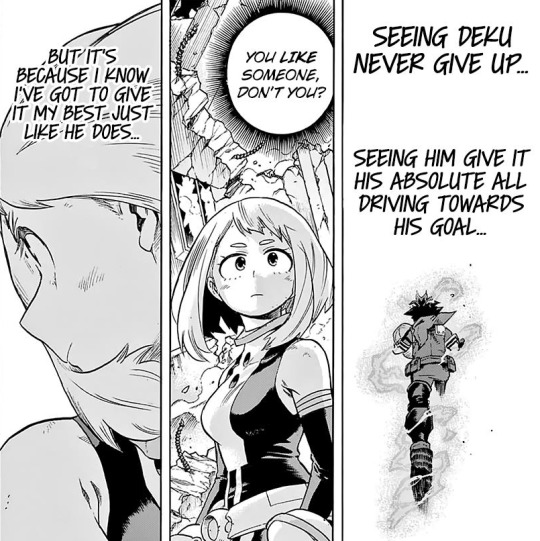
Her crush is literally founded on an appreciation for Midoriya’s drive, earnestness, and constant growth as a person.
But these are all traits that Shigaraki also explicitly possesses. Shigaraki’s unwavering resolve is so strong that even though everyone around him says dream is unattainable... they follow him anyway.

Ujiko flat out tells Shigaraki he’s chasing a pipe dream, but he’s willing to come along for the ride strictly because of how committed Shigaraki is to making that dream a reality. The strength of Tomura’s conviction alone persuaded a collection of the most volatile and difficult personalities in the manga to band together and become found family the most well-known anti-establishment organization in all of Japan.
Shigaraki never, even in the face of overwhelming threat, backs down from a challenge, and he approaches each impossible task with absolutely as much effort, ferocity, and refusal to quit as Deku. He is just as dedicated, just as much of a shounen protagonist main character, and just as willing to push himself above and beyond as Deku.

The traits that motivated Uraraka to become the character she is today, many of the exact same traits that formed her crush on Midoriya, are all there in Shigaraki. In another world, the person who inspired Uraraka to go “Plus Ultra” could be Tomura himself, and if 1) no sense of self-preservation, 2) ZERO CHILL, and 3) dogged obsession are what Uraraka finds attractive, Shigaraki clearly has 'em covered. Oh no, he’s meeting all my standards.
2) Being serious though, Ochako’s role in the plot would be vastly improved by more meaningful interactions with the antagonists, even if just in battle.
I’ve written before about how badly the writing of BNHA treats Ochako, and why her constantly being out-of-focus is a hallmark of the genre’s crippling inability to handle dynamic female characters, but it bears repeating: in her current position in the story, Uraraka’s character has minimal agency. She exists to fill the role of Deku’s love interest (at worst) and an emotional crutch (at best). Again, absolutely no hate on the IzuOcha ship--it’s clearly canon endgame and “wholesome” I guess is what they’re calling it nowadays. But the way IzuOcha’s being written in canon is actually the worst possible thing that could happen to Uraraka’s individual character, because Ochako’s crush on Deku has been given virtually no bearing on the story’s main plot and allows Horikoshi to consistently reduce Uraraka’s personal accomplishments to “inspirations from Deku” (in order to, likely, fulfill young male readers’ fantasy of having a girl fixated on them).
Is Uraraka about to do something cool in the manga? Wait for her comment about being motivated by Deku.
Does Uraraka actually get to see some action and get involved in a fight? Wait for someone to bring up her feelings for Deku.
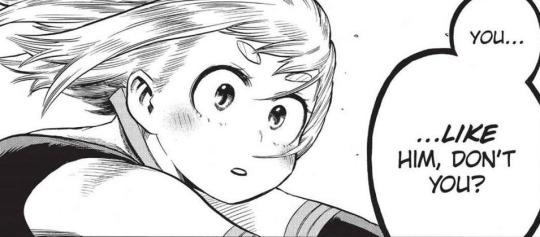
Is Deku about to have a dramatic clash with the story’s villains to advance the main plotline? Wait for Ochako to entirely vanish (at worst) or get sidelined into a three panel clip where she’ll use the same martial art move she’s been using since like chapter 10 (at best).

If I have to read “Gunhead Martial Arts” one more fucking time... Give Ochako her OWN supermoves goddammit!!
The story of the comic itself continually pushes Ochako out of any position of relevance. She’s not one of UA’s strongest fighters (despite having a quirk that, if applied like ANY of the male characters, has incredible potential), she’s not given half the emotional depth or attention even side characters like Kirishima get, and her backstory lacks the development many of the male characters’ get (I’m looking at you, Todoroki).
As a “good girl,” she isn’t allowed to get her hands dirty like Toga, she isn’t allowed to get as bloodied or ugly as any of the boys, and she can never be allowed to surpass the main male characters in coolness or plot relevance because girls can be “heroes” but they can’t be The Hero™. (I’m literally gagging, guys.)
Which is EXACTLY why a plot involving Shigaraki and Ochako--in ANY capacity, even just a flat out fight against each other!--would actually be a fan-fucking-tastic addition to BNHA.
Skip the token Toga vs. Ochako chick fight where they squabble over who loves Izuku more. Let Toga talk to Izuku as herself for once. Let Uraraka throw down with the League’s leader. At least once, Horikoshi? Just once?

Literally any form of plot that puts Shigaraki and Ochako into contact would mean moving Uraraka into a more central position within the manga’s plot, would boost her screen-time, increase the likelihood of her contributing to the story’s primary conflict, and would give her more to do and emotionally engage with than just repeating the same lines about Deku being amazing on an endless loop. There is untapped character development potential in spades here if Uraraka was given chance to genuinely interact with the other half of the story’s cast!
Give👏 Uraraka👏 something👏 meaningful👏 to do!👏
Putting the story’s foremost female character on out there on the frontlines with the manga’s actual main character antagonist would finally break her out of the mold she’s been forced into by genre stereotypes and set her on an even playing field with the male heroes at last.
A meaningful encounter with Shigaraki could be Ochako’s ticket to being treated respectfully by the story itself (and hell if giving underappreciated characters a real place in the world isn’t Tomura’s freakin’ calling card already).
3) Okay, I know the words “subverting expectations” leave a bad taste in everyone’s mouth nowadays, but there is a huge difference between “throwing inexplicable plot twists at the audience just for shock factor” and “averting stale cliches in an emotionally rewarding manner.” Sure, cliches do exist for a reason, but there are still many instances where actively avoiding a cliche plotline is a great choice. A shounen manga’s token love interest ending up with someone other than the hero--namely with a (reformed) villain--would be an interesting flip on the trite “hero gets the girl” script.
Look, we all know how it goes: Hero clashes with Bad Guy. They duke it out all over Kingdom Come. RIP like fifty square city blocks. The Hero wins, heads home triumphant, sweeps his Princess off her feet, and sails off into the hero rankings sunset. End of the same story we’ve seen a million times. Sometimes it’s done well and the audience is left satisfied. Other times, the heroine involved is reduced to the hero’s reward, less person than wish fulfillment. In either case, tying up a romantic subplot with a hero is the go-to way of resolving female characters’ storylines and, at this point, pretty much a given in manga, even when the romantic subplot is never given the development it deserves, leaving audiences bewildered at how and why the hook-up actually happened.
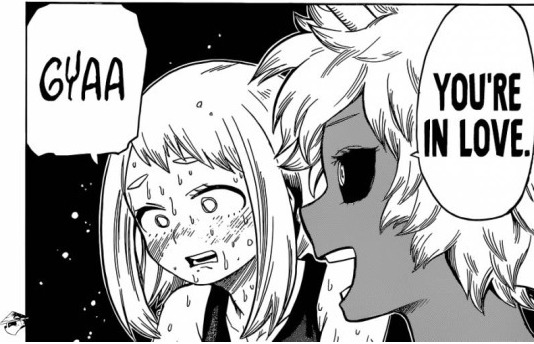
I’m not saying every comic should “subvert expectations” and cancel its romantic subplot between the hero and heroine, of course not. But I am saying that it would be pretty refreshing to see something else for once.
By virtue of their role, villains don’t usually “get the girl.” Even redeemed villains rarely end up in happy, healthy, well-written relationships. It’s not impossible but it is unlikely that a series’ designated female lead ever wavers in her attentions from the main hero to a new romantic target.
So it would be pretty cool if one did, if the moral of the story’s romantic subplot wasn’t just "token love interest completes painfully shoehorned romantic gestures.” A good romance with a redeemed ex-villain instead of a hero would take a lot more explanation. It would demand, by its very nature, more work on the author’s part to suspend disbelief. The characters would have to develop an entirely different rapport from the normal interactions between designated love interests, and, to a certain extent, strong character growth would be required in order for such a romance to even get started. There’s more moral complexity and conflict to a subplot like this, and a greater sensation of choice--if the heroine doesn’t have to end with the hero by the end of the story, well hey... That means she could end up with just about anyone. Whoa.
Even more so, in the specific case of Shigaraki, who has lived a life of misery and manipulation, the idea that he could come out on the other side, grow as a person, redeem himself, and eventually enter a healthy relationship with someone who isn’t going to hurt him is an idea I find deeply appealing. I think there are a lot of villain stans, myself included, who see parts of themselves in Shigaraki. If a character who has been so severely impacted by abuse can still heal and ultimately end up happy, to me, that’s a far more hopeful and heart-warming conclusion than the alternatives. I did warn you this manifesto would be rose-tinted, didn’t I?
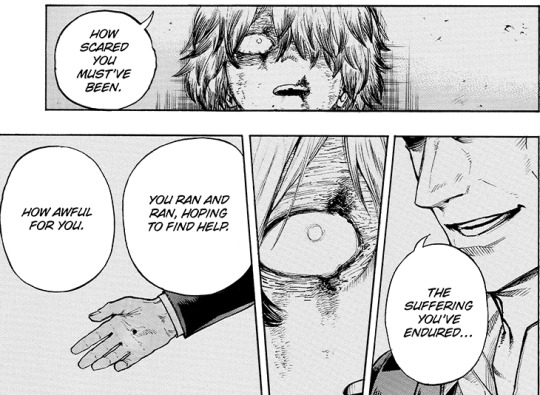
I want storylines that prove that none of us are beyond saving. That people who make bad choices can still change. That romance isn’t a reward for playing the “right” role. That heroines have options. That there are still pleasant surprises to be found in romance plots.
4) But why Shigaraki and Ochako, in particular? It’s not like they have any remotely shared life experiences--
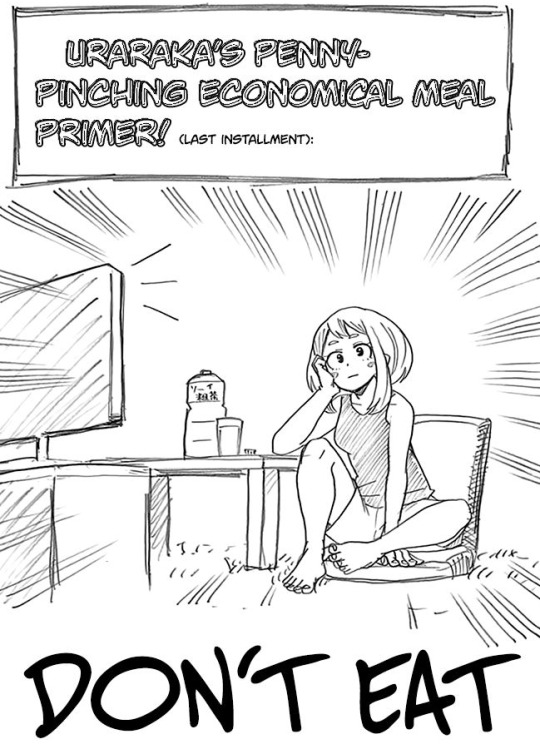
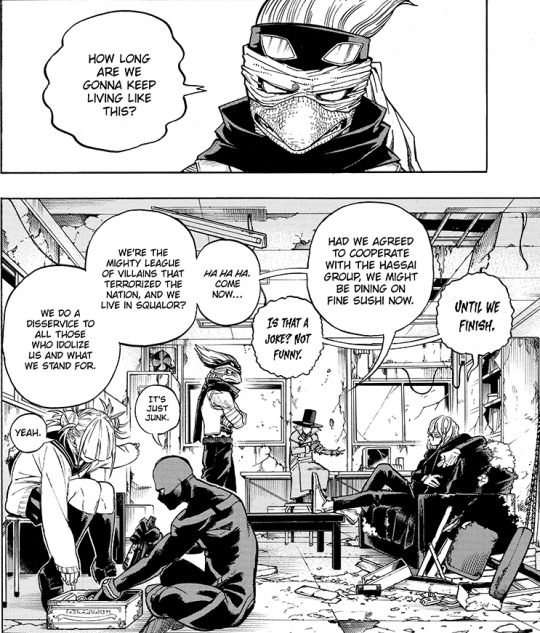
Oops. Friendly reminder: Ochako is the only major character in the manga besides the villains who is overtly described as, I quote, “poorer than poor.” Todoroki, Yaomomo, and Iida can all make it rain; Kaminari, Mina, and Jirou can afford stylish clothes; Kirishima can drop a stupid amount on night vision googles... Even Midoriya, whose father “works overseas,“ can afford plenty of All Might merchandise. One of the popular fandom theories for a while was that Ochako could be U.A.’s traitor specifically because of her desire to help her parents financially, and I think that most readers at this point can discern a clear divide in BNHA’s society: heroes are the “haves” and villains are the “have nots.” To be a hero in this story is to attend a prestigious school, have access to expensive support items, gear, insurance, fame and glory, etc.
Meanwhile, with the exception of All For One, to be a villain in BNHA’s story is to be marginalized, live in unfit conditions, lack access to basic safety and nutritional resources, and struggle to make ends meet. When ability to thrive in a hero-centric society is synonymous with being a good and worthwhile person, anyone who doesn’t just naturally excel in the hero-driven economy is treated as flawed at best and suspect at worst. Poor characters in the story are ignored, and, as demonstrated with people like Twice, left essentially to fend for themselves.

Uraraka’s status as lower income is mostly played for laughs. She’s still a privileged character in that she can attend U.A., receive hero items for free, has a safe place to live, etc. But it is important that the story acknowledges her family’s situation, because her financial status does set her apart from her classmates.
She is less privileged than the others. Being “the poor character” situates Uraraka in the interesting divide between those who couldn’t cope and chose to rebel against hero society instead, versus those who conformed to the hero system in an attempt to improve their situations. In different circumstances, if Uraraka’s family was just even the tiniest bit worse off, we might be seeing a very different character here, one who had to make some much harder choices to keep her family afloat.

Having been in the position of "going without,” Uraraka also has a unique understanding of the “real world” that many of her heroics classmates might lack. She understands what it is like to go hungry, to not be able to afford to keep up with the newest trends, to be constantly anxious about the future--to feel unsuccessful, overlooked, and under constant pressure to perform. As someone who wasn’t raised in the lap of luxury or even really a middle-class home, Uraraka has more insight into--and would likely have more empathy for--the plight of the downtrodden daily criminals of the BNHA world. Just based on her own life experiences, Ochako is more likely than her classmates to recognize how harsh reality can be, and understand the temptations that lead people to make terrible decisions.

This makes Ochako an especially interesting character in terms of her pro hero future. Would she be able to sympathize and reach out to struggling "villains” more effectively than others from her class, who lack her humble background? Would she be able to better see the big picture of BNHA’s society, and the way it actively creates villains from its marginalized populations? Would she be able to look at the League not just as criminals, but also as people who never stood a chance within the confines of a rigged social structure?
Uraraka’s background shifts her closer to the story’s villains than many of the other hero characters, and puts her in a unique place to both empathize and become motivated to change the flawed system that produced people like Shigaraki and the League in the first place.
5) Likewise, Uraraka’s background actually makes her more palatable to Shigaraki than other heroes. At least at the beginning of the comic, Uraraka isn’t shy about admitting that one of her reasons for becoming a hero is to help her parents financially. Ochako’s original motivation for heroism isn’t portrayed as nobly as others’ like Deku--Deku has no ulterior motives for being a hero; he just wants to save people and wouldn’t care about personally benefiting.

Instead, Ochako is presented as someone who (initially) sees heroism as a means to an end. It’s not that she doesn’t want to save people, but that she’s not doing so only for the intrinsic worth... the hefty paycheck that comes from heroism is a big draw.
Over time the manga has shown her shifting away from this (which actually makes her character less unique, unfortunately), but I’m sure it’s still a thought for her, and she’s definitely going to send paychecks to her parents in the future. At the end of the day, heroism is still going to be Uraraka’s ticket to a better lifestyle, even if she’s committed herself to it honestly by the time she leaves U.A.
But it’s this exact form of personal motivation that Shigaraki is much more likely to understand than the “goody-two-shoes” motivations of people like Deku. Multiple times in the comic Shigaraki has expressed confusion with society’s habit of clinging mindlessly to symbols, of their blind faith in the virtues of heroism, and their ability to simply overlook suffering because “surely a hero will do something about it.” Stain’s ideals about “true heroes” go straight past Shigaraki, who seems to hate heroes who are earnest (All Might, I’m talking about All Might) far more than those who are simply faking their way through for fame.
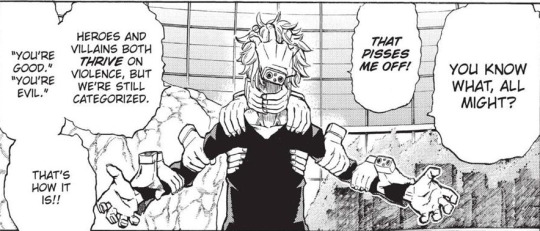
Shigaraki understands humans who are driven by personal gain. He respects the individual desires of people he cares about. Someone in the hero industry explicitly seeking tangible benefits would likely, to Shigaraki at least, come across as more genuine than someone who claims they have no ulterior motives, and a person who is blunt about their needs and grounded in the reality of BNHA’s world would likely be much more acceptable to Tomura than someone who spews trite lines about peace and justice.
Shigaraki’s feelings for heroes have been irreparably damaged by his conditioning from All For One, but there are certainly some heroes that he would find less loathsome than others. He will probably never understand Deku’s selflessness. All Might’s saccharine symbolism actively infuriates him. But a person who became a hero to put food on the table? To provide for her parents (maybe especially because it is her parents she’s trying to provide for)? That’s at least understandable. If the manga’s future does see Shigaraki redeemed, my thought is that the only type of heroes we’ll ever see him willingly interact with would still be heroes just like Ochako, with more “down to earth” personal motivations. Uraraka, your codename is “If I had to date a hero”...
6) While we’re talking about shared life experiences, there’s another very obvious similarity between Shigaraki and Ochako: neither one of them can touch things with all five fingers.
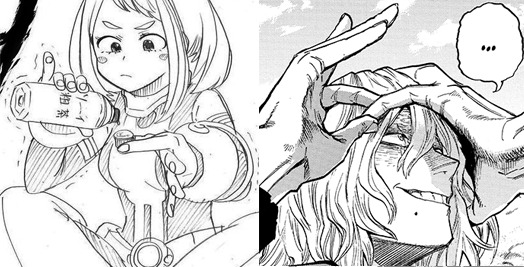
Cute/fridge horror observation: Shigaraki is even daintier about touching things than Uraraka is; Uraraka usually lifts just her pinkies, but Shigaraki frequently uses as few fingers as possible.
Yeah, yeah, they both have to be dainty and careful with everything they hold. It’d be cute to watch them eat together. They could mutually gripe about the annoyance of video game consoles not designed for four-finger use. More than that though, neither one of them can touch other human beings without the risk of causing death.
Uraraka, as a hero, has the more privileged quirk design (she can turn her quirk off, while Shigaraki can’t) and until recently, the comic was always very careful to portray Uraraka’s quirk in a way that no one was endangered by it. But dropping Zero Gravity into the hands of a villain for a single chapter reveals the truth: Uraraka’s quirk has just as much lethal potential as Shigaraki’s.

Like Shigaraki, Uraraka has to face the reality that her touch alone could jeopardize the safety of anyone she comes into contact with, in her daily life and in her hero work. Drop some debris without looking twice? Just crushed a civilian. Release your quirk without thinking? Now the villain you floated is paste on the sidewalk. Thought that it was safe to float away the building? Oops, you crushed someone still trapped inside. Yikes. In a one-on-one battle, Uraraka is actually at a disadvantage not because her quirk is weak, but the dead opposite--in an outdoor fight, she would have to actively work not to accidentally send people off into outer space.
Having an auto-activate touch quirk means that both Shigaraki and Ochako have to be conscious of every single thing they touch all the time. Both of their quirks require constant bodily awareness, and both come with the lurking knowledge that “My touch causes problems.” Even for Ochako, who would merely be a nuisance if she accidentally floated objects indoors, it’s easy to internalize frustration and negative associations with one’s own body. Every day, Ochako has to be careful with herself in a way that few of her peers do, another factor that sets her apart.
One of the story’s overarching themes is the idea of “self-acceptance” and what it even means to “accept yourself” in a world where (almost) every human being possesses a distinguishing feature, often built into their bodies at the expense of standard human functioning. For people with limited control over their quirks, who can’t choose when the effect activates, a quirk is a constant burden and facet of their identity that entirely re-shapes how they interact with the world. Both Shigaraki and Uraraka face the practicality of having burdensome, even lethal, auto-activate quirks that require constant self-awareness. This is a similarity that, of the major characters, only Shigaraki and Ochako possess so far. (Even other major characters with touch-based quirks like Overhaul appear to be able to choose when to activate their quirks).

The “funny” way Shigaraki and Ochako hold things seems like just a small similarity until you remember the amount of practice and frustration it must have taken to internalize a four-fingered touch. Until you remember that this similarity marks them both as very careful and self-conscious characters. Until you remember that Shigaraki’s got a one-touch instakill... but so does Uraraka Ochako.
7) Okay, similarities are cool and all, but you know what they say: opposites attract. And if we’re talking character motivation, there are no cleaner opposites in the entire series. Shigaraki and Ochako are actually even better emotional foils than Shigaraki and Deku, because Ochako’s central motivation is “Make as many people smile as possible” and Shigaraki’s is, literally, “Make it so no one can ever smile again.”
I know I ragged on it earlier, but now I’m going to use it to my full advantage: as the story evolved and characters grew, Ochako’s “true” motivation to become a hero revealed itself: she feels a deep, intrinsic happiness when witnessing the happiness of others. Her desire as a hero is to spread relief, the sense of security that allows people to go about their days smiling. She literally feels happiest when everyone around her is happy.

Even more so than Deku, this casts Uraraka as Shigaraki’s diametric opposite in the story, because Shigaraki’s entire pipe dream goal also hinges on the smiles of others--and how absolutely much he hates them. Shigaraki’s goal is total world destruction because he just resents the happiness of others that fucking much.
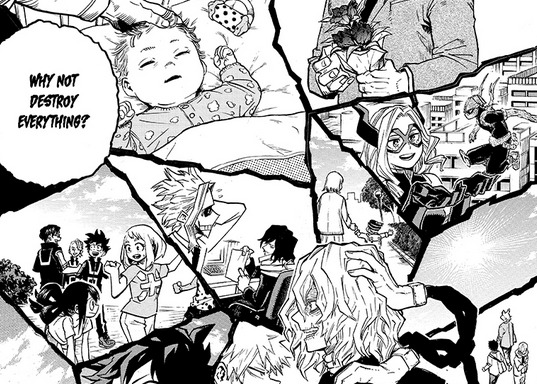
On the surface alone it’s more fascinating than the story will probably ever live up to: Ochako, the heroine who wants to spread smiles; Shigaraki, the villain who wants to destroy them. Even if we’re just talking canon, zero romance involved, that would still be an interesting conflict to explore. The story could cover a lot of deeper ground by drawing the comparison between these two characters more directly. It would definitely validate Uraraka being involved in more major plot events, at the very least.
BUT this was supposed to be about shipping, so of course I can’t leave it there, and leaving it there would only be half the story anyway, because nobody is born hating smiles. Everything we’ve seen of Shigaraki’s past so far indicates that he was a kid with a cute dog, a warm relationship with his sister, and an interest in heroes--i.e., a decent life that probably included his own fair share of smiles. Shigaraki’s hatred and resentment are direct products of the traumatic manipulation he suffered at AFO’s hands. He despises the idea that people around him can smile and act upbeat, even when they objectively know villains are lurking all around them. He is actually sick to his stomach at the idea of people blindly putting their faith in heroes, knowing what he does: that heroes often fail, that there are many people who desperately need to be rescued and are instead overlooked. The world failed Shimura Tenko and then had the nerve to keep on smiling without him.

Other people’s smiles represent nothing but the joy, security, love, and peace that Shigaraki Tomura hasn’t experienced since the day his quirk manifested. The sight of any living thing fills Shigaraki with rage because everything bright and beautiful, everything good and calm and kind and soft and warm, is everything that Shigaraki has lost and believes he will never, ever get to experience again.
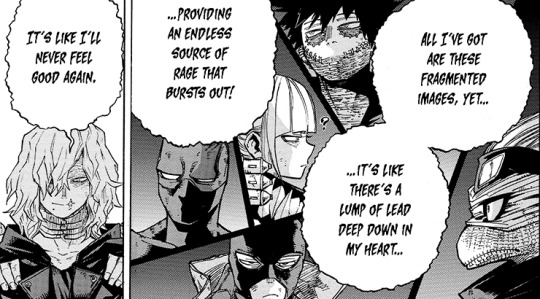
Shigaraki doesn’t really hate the pure happy smiles of others; he hates the fact that the world has taken away every single thing he ever had to smile about.
It is my belief that Horikoshi is hinting at a redemption arc for Shigaraki, especially as we see the League become closer allies. But Shigaraki can’t be completely redeemed, can’t be persuaded to give up his world-destruction plan, until he can look at the smiles of others without scorn. Until the bright, upbeat attitudes of heroes other people no longer feel like a personal attack. Until he’s happy enough that the happiness of others no longer hurts. Until the weight is lifted.
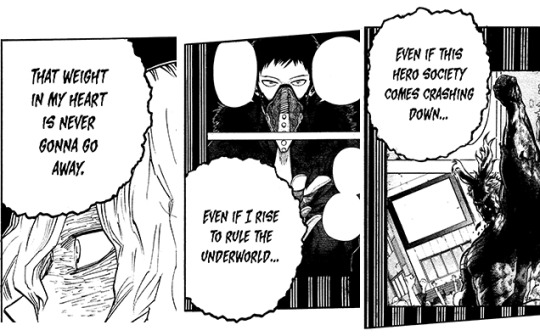
And I can’t think of any character more obviously suited to helping lift an immense weight than Uraraka, the zero gravity hero who wants nothing more than to spread smiles.
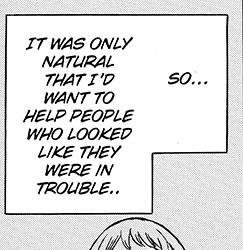
8) Speaking of lifting weights... Kacchako is a popular ship stemming in large part from Bakugou’s refusal to treat Uraraka with kid gloves. He faces her head-on as a real opponent and views her like any other hero hopeful.
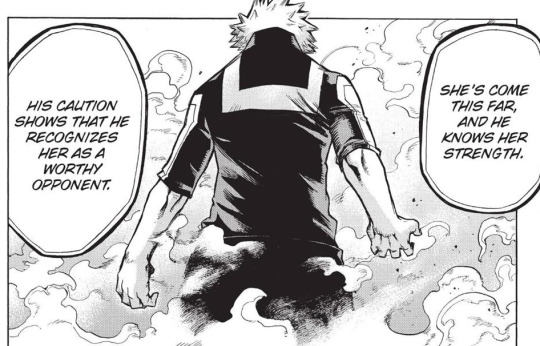
As I’ve said before, this is pretty much the most respectfully the series itself has ever treated Uraraka Ochako, and it caught a lot of attention because it was one of the rare occasions that a female pro hero-in-training was really treated as an equal to the male characters. Kacchako shippers had something awesome to work with.

But... You know who else treats women as equals? (Hell, you know who treats literally everyone as equals, from those with mutant quirks to trans people to those with severe mental health issues?) You can say what you want about Shigaraki’s habit of, you know, mass murder, but in terms of viewing others equally and respecting (okay, let’s be real, it’s probably closer to just ignoring) differences, Tomura is about as open-minded as BNHA characters come. The League is an equal opportunity employer.

Unlike actual hero characters, Shigaraki has never once suggested that Toga is incapable of keeping up with any of the male members of the League, and in fact has entrusted her with many of the League’s most dangerous and crucial missions. He explicitly has faith in her ability and skill.

Toga’s right there in the fight against Gigantomachia and the QLA, as much an equal member of the League as anyone else. In terms of gender equality, the villains seem to be light-years ahead of their hero counterparts, and Shigaraki in particular doesn’t discriminate, among his allies or his opponents either. He’s not a “spare the women and children” kind of guy; every hero and villain challenger is treated with equal violence (and equal snark), whether they’re male, female, a long-time pro or a student in training.
In whatever context--canon opponent, AU ally, or a future romantic interest--Shigaraki would take Ochako just as seriously as Bakugou did. If you like Kacchako because Bakugou doesn’t dismiss Uraraka, that same dynamic would be present in Shigako too.
9) And on the topic of Shigaraki and women... It doesn’t feel accidental that every single female character who ever had love for Shigaraki has been taken away from him. A distinct part of Shigaraki’s storyline is that all positive female role models have been systematically removed from his life. He lost his grandmother, a hero he could have looked up to; he lost his mother, who he now has no memory of; he lost the older sister he clearly held dear... All For One’s control over Tomura has always been total, but this particular detail feels especially insidious: was All For One’s spite for Nana so strong that he delighted in deliberately destroying every single relationship Tenko had with women connected to Nana’s legacy? (Or is AFO perhaps just a raging misogynist? Every single one of his known associates is male and he seemed to despise and mock Nana particularly hard...)

In any case, the point I’m trying to make here is that, even ruling love interests out, Shigaraki’s storyline would be enriched by forging a meaningful connection with a female character like Ochako. Acceptance--maybe even some grudging admiration--for a female hero? A fantastic opportunity to show just how different the “villains” are from the discriminatory society that produced them. Supporting friendship while he’s on the road to recovery? A+ way to diversify interactions between the male and female cast. Send a tough girl to Tartarus to question his motives? Nice chance for tense dialogue and some good old noire-esque foe yay. Hostage situation that takes a turn for the surprisingly cordial? Fun way to explore different dynamics and humanize the villains because hey, they treated the “damsel” to dinner shortbread cookies. My god, Shigaraki could even develop some positive sense of rivalry with a woman, for example! The possibilities are endless if you’re actually willing to give female characters a shot!

Being more serious, Tomura’s life has been dramatically marked by the loss of his female family members, and--at least from what we know so far--his entire youth was spent without the presence of reliable friendships, let alone any form of “love” that wasn’t disturbingly fake. Beyond his fragmented memories, he has no models for healthy relationships, romantic or otherwise.
Letting Shigaraki develop to the point that he could form a mutually positive relationship with a female hero character would be extremely cathartic for me as a reader. I don’t mean “rewarding redemption with a last-minute happy ending romance”--I mean actually getting the opportunity to watch Tomura rediscover what it means to be genuinely loved and realize he has the capacity to give love and be happy in return...

Reaching that level of mutual support and closeness--especially with a female pro hero--would be the biggest “FUCK YOU” that Shigaraki could give to All For One, short of, you know, actually killing him.
Shigaraki Tomura has a critical (and deliberate) lack of healthy connections to women. BNHA, coincidentally, has a criminally under-utilized female lead just twiddling her thumbs over here, waiting for a meaningful plotline to be thrown her way.
Sure, putting AFO in prison is cool and all, but have you considered... crushing his pride and legacy of evil by helping the boy he tortured for years learn to love again? I’m just sayin’!
Uraraka Ochako, snatching Shigaraki right the fuck out of AFO’s hands:

10) Basically what the whole thing boils down to is this: Shigaraki Tomura needs a hero.

Don’t mistake my meaning. A lot of “girl meets bad boy” plots end up amounting to “girl becomes emotionally responsible for fixing bad boy’s issues,” and that’s not what I’m gunning for--Shigaraki has to redeem himself because redemption is only meaningful when it stems from the character’s own inner desire to change; I’m not quite rose-tinted enough to buy into the Love Redeems trope myself. I’m definitely not advocating anyone dump Shigaraki Tomura as he is now into Uraraka Ochako’s lap and expect her to turn him from a beast to a beauty. It’s not an unrelated woman’s responsibility to fix a broken man.

But! From a reader’s perspective, I think we can agree: Shigaraki’s redemption cannot be complete until he learns to believe in real heroes. He doesn’t have to like them. He doesn’t have to support hero society. But he has to be able to look at real heroes like Izuku and Ochako and admit that they are doing what’s right--that society is a better place because they are here. Shigaraki’s path to recovery can’t even begin until he’s capable of at least acknowledging that the world has things worth saving in it.
If Horikoshi moves forward with a redemption arc for Shigaraki, it will probably be Deku who Detroit Smashes the message of truly noble heroes into Shigaraki’s head. That’s his job as the resident Warrior Therapist, I suppose. But you know... to me, it might be even more meaningful if Shigaraki’s hero--if the hand that reaches out to rescue him--isn’t The Hero’s™ but just a hero’s. We all know Deku is selfless and good to the core. As All Might’s perfect successor, he really has nothing to prove. It’s everyone else who is in question. It’s the whole rest of hero society that owes Shigaraki Tomura an explanation for the suffering of people like the League’s members. It’s everyone else who needs to prove they can do better--that in the future, there will be no bloody children left abandoned in back alleyways.

Uraraka Ochako’s conviction is to save people. As a female hero who hasn’t lived a privileged life, she’s uniquely situated to think about those who are most often overlooked. In a world where violence begets violence, where only those with strength and flash excel, what a powerful message it would send for the terrifying antagonist to effectively be rescued by someone the story itself has called ���a frail girl.” At the end of the day, heroics isn’t supposed to be about mountain-destroying explosions and mach punches--heroics is supposed to be about heart, about reaching out a gentle helping hand, about spreading smiles to those who need them most.
Tomura’s faith in heroes has been brutally stripped from him, and every part of his conflict is tied up intimately with his misdirected hatred: it wasn’t actually heroes who isolated and hurt him--it was villains. In order to move forward, he will have to come to that horrible realization, deal with that means for himself and his place in the world, and recognize the truth: there are goodness and good people in the world. Selfless heroes, those who wouldn’t turn their backs on a crying child, do exist. There are people, even now, who would extend a kind hand to Shigaraki Tomura and do their best to bring a real smile to his face. Because that’s what’s really going on, after all.
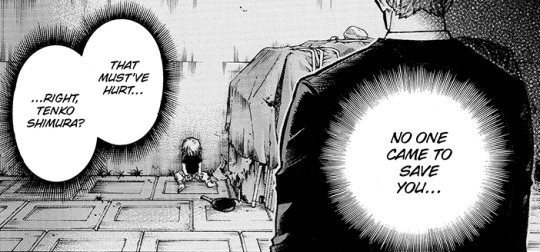
Shimura Tenko is still waiting to be saved.

And I know just the person to do it.
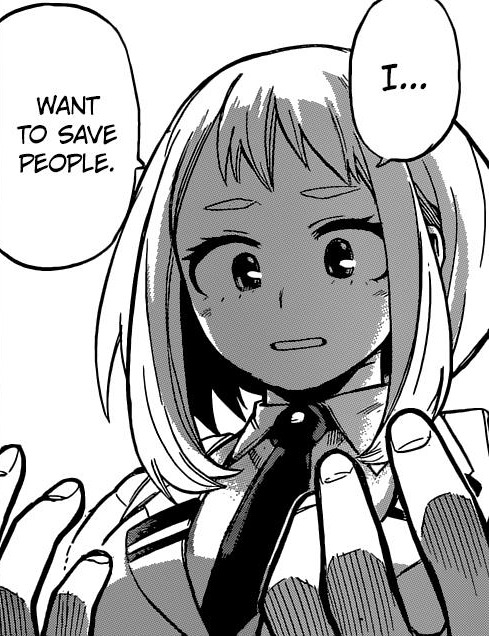
#Shigaraki Tomura#Uraraka Ochako#Shigaraki#Ochako#Shigaraki/Ochako#Shigako#OTP: Stardust#boku no hero academia#my hero academia#bnha meta#discussions of abuse#discussions of poverty#in which I spill an entire pot of tea#regarding BNHA's#female characters#this started out as a joking request from a Discord servermate#and turned into this beast#I love this ship so much#when will the rest of the world awaken#ohmytheon#mistystarshine#I blame y'all for this
437 notes
·
View notes
Photo

I’d comment that Phos’s complaint about the final level of their game being ridiculously hard is a metaphor for how their entire quest gets exponentially more difficult as it approaches its conclusion, but the blurb in the margins already points out that parallel, so I guess my observation is redundant. The accursed little thing is stealing my thunder.
Click the read more if you want to see me read way too much into the art.
Before I get into gushing over the artwork, I want to go over some of my thoughts on the narrative side of things, so let’s get the most annoying part out of the way first and talk about Aechmea.

I’ve heard that in the original Japanese, it’s clear that he’s referring to Cairngorm. What’s interesting here is that he said this line when it seemed for a moment that Kongou was about to release the Lunarians. But now that it’s clear it won’t happen, I wonder whether or not he’ll actually say what was on his mind. In any case, I can’t wait to see more of his ugly mug next chapter. Yay.
This chapter has sparked a bit of discourse regarding the earth gems, so I might as well chime in. While I agree that the earth gems’ reaction isn’t unreasonable given the circumstances and the limited information at their disposal, it’s still not really the best reaction they could have had. Regardless of their interpretation of Phos, the truth of the matter is that the version of Phos that the other gems feel the need to shatter, tie down, cage, and then shatter again is less of a threat to Kongou than the one they let walk around freely in chapter 58. Just because what they’re doing is understandable, doesn’t mean that what they’re doing is right, and I don’t think that this pattern of shooting first and asking questions later is a good road for them to collectively go down.
And on the subject of Euclase, to reiterate what I’ve said before: they give me the willies not because I think their actions are totally unreasonable, (though said actions do tend to be on the more militant side of what could be considered reasonable, don’t they?) Rather, a lot of the bad vibes I get from them are because of the menacing manner with which Ichikawa sometimes frames them, in addition to Padparadscha’s seemingly less-than-charitable opinion of them.
I’ve been curious for a while now about how Rutile would react after Padparadscha outright rejected them. Looks like they’ve just doubled down on their obsessiveness, to the point of doing a stellar Onryō impression. Really, the quickest way to ruin a relationship in this story is to either take someone for granted, or to be possessive/controlling. Phos has some issues with the former, but a number of the other characters have a strong case of the latter, case in point being Rutile here.
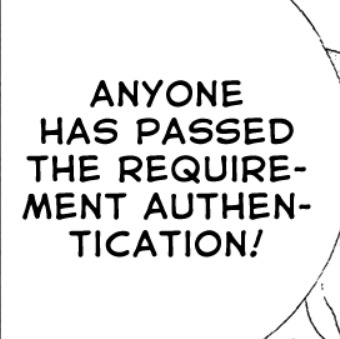
I’m guessing that this implicitly confirms that the human particle is indeed in Phos’s eye? I doubt that Kongou’s human sensors would go off due to Phos being merely metaphorically human. I’ve also seen people posit that the reason Kongou can’t release the Lunarians is because his one-way ticket to nirvana only works on less sentient life forms. (@rinboz has a good analysis that touches on this topic, btw.) I think the chapter confirms this interpretation based on Phos’s mysteriously disappearing cage. And that dovetails nicely into my thoughts on the art of this chapter…
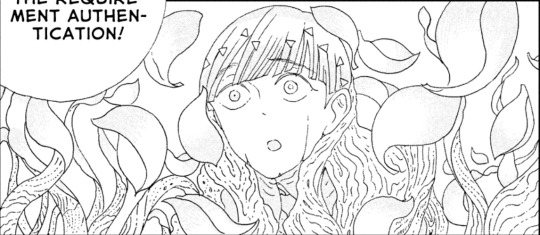
Because the imagery of the cage coming to life, flowering, and vanishing in a breeze of petals is *chef’s kiss* gorgeous.
The scene starts off in gray and black, and the panels have a cluttered, claustrophobic feeling to them from the grain of the wood and the shadowy, looming architecture. But once Kongou begins his prayer attempt, the panels start to become more spacious, those grays and blacks giving way to sleek monochrome. Finally, this changes to stark white with minimal linework and virtually no shading. The only other time I can recall Ichikawa using this blank, simplified style in hnk was when we saw a brief flashback of Phos as a child. (For a given value of “child,” we are on arrested development island after all.)
The way the cage seemingly transformed back into an earlier phase of its existence before vanishing reminds me of how Shiro went back to being a dog for a few moments before he left. So, it seems that Kongou’s attempt worked just fine on a wooden cage—i.e, a plant—but none of the sentient beings present could actually be affected.
Once he fails, the shroud of grey once again falls over the scene, black arches closing in. And yet when the “camera” turns to Phos, their greyscale body is surrounded by white, as if the pure vision they had just seen is still haunting them.
I’m just in awe of how perfectly the environment here mirrors Phos’s emotional state. Their heavy bondage flies away in a flurry of petals just as they’re getting their hopes up, and in the moment that those hopes are dashed, the rain of blades that shatter them are represented as black bars caging their mangled body. Have I said before that Ichikawa is an absolute master of visual metaphor? Because she is.
I was so fond of the art, as a matter of fact, that I reread the chapter several times and kind of. Stared at it for a couple hours. Here’s some interesting things I noticed.
In chapter 71, Cinnabar’s mercury globules were gone, but now they’re back. Were they gone before because Cinnabar had just unloaded a bunch of mercury the previous chapter, or could there be some other reason? Also in regards to Cinnabar, they’re present while Phos confronts Kongou, just barely visible on the far left—note the floating mercury.
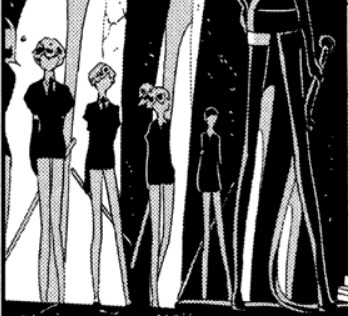
But at no point does Ichikawa let us see their face or what they think of all this—more on this in a moment.
Bort doesn’t seem to be wearing powder on their left leg. It’s the same leg that Phos shattered, and as far as we know, that’s the only time they’ve ever been broken, so maybe they’re leaving that leg bare as a reminder? That seems like the sort of samurai-esque thing Bort would do.
Everyone’s started wearing gloves. Before, the gems with a <9 hardness would only wear gloves if they anticipated having to touch someone or something with a different hardness level, (or in Cinnabar’s case, if they didn’t want to contaminate the things they touch.) But in this chapter, everyone’s wearing gloves the whole time. There are two possibilities that come to mind for me. One is that since the earth gems have to anticipate fighting other gems instead of cloud-people, they have to worry about abrasions to their hands while fighting, and are thus patrolling with gloves. The other possibility is that since Cinnabar has been fully (?) integrated into the group again, everyone has to be careful of what they touch, and they’ve taken to wearing gloves to lessen the risk of being contaminated by mercury.
Peridot and Sphene aren’t wearing gloves while patrolling in chapter 69, even though the earth gems were definitely counting on fighting the gems on the moon sooner or later, which makes me think it’s more likely that Cinnabar is the reason everyone’s wearing gloves. Maybe it went something like this: up until the night raid, Cinnabar hadn’t been living with the other gems despite the fact that they must have been engaging with them. But after the night raid, they start living with the others in the school, thus necessitating the gloves.
Once the sleep deprivation started kicking in I found myself engaging in the potentially meaningless venture of counting swords, gems, and who had swords and who didn’t in the second half of the chapter. I may have found a couple of interesting things, so get your tinfoil hats ready.
On this page, we see all the earth gems sans Jade and Euclase, and of those gems, Sphene, Cinnabar, Obsidian, and Red Beryl are unarmed. My first observation is that one of the gems who was unarmed grabbed a sword from somewhere and threw it at Phos. There are only seven swords on this page, but—not counting Rutile’s scalpels—there are eight swords on the ground on the final page.

Which begs the question: who threw the mystery sword? We can rule out Jade or Euclase; they were standing in front of Phos and it’s clear from the positions of the blades on the ground that they were all thrown from behind. Best-case scenario is that Sphene simply set their sword aside while checking the cage and grabbed it again off-panel. Worst-case scenario would be if Cinnabar was the one who chucked the eighth sword at Phos. I’m just gonna hope that they’re too frail to pick up a sword in the first place; please don’t dash my hopes Ichikawa.
Speaking of which, on the penultimate page, there are eight lines piercing Phos—one for each sword on the last page. This makes me wonder: did Bort not attack Phos here? Their whip is seemingly unrepresented in the stylized depiction of the weapons that shattered Phos, and it’s not entirely clear from the last page whether they used it or not. Then again, Rutile’s scalpels are on the ground on the last page but absent from the previous page, so maybe I’m reading too deeply into it. But the fact that Ichikawa was careful enough to have the number of swords match the number of black lines makes it a possibility worth keeping in mind.
This is what happens when I’m assigned to read The Tedious Misadventures of Tristan and Isolde. I start procrastinating by going all True Crime over who exactly murdered Phos. Anyway, see you guys next month when we find out whether the earth gems were nice enough to put Phos back together or if they just chucked the pieces out to sea.
146 notes
·
View notes
Text
Medieval Magic Week: Witchcraft in Early Medieval Europe
Apologies for not getting to this last week, but I will try to be at least semi-reliable about posting these. If you missed it: I’m teaching a class on magic and the supernatural in the Middle Ages this semester, and since the Tumblr people also wanted to be learned, I am here attempting to learn them by giving a sort of virtual seminar.
Last week was the introduction, where we covered overall concepts like the difference between magic, religion, and science (is there one?), who did magic benefit (depends on who you ask), was magic a good or a bad thing in the medieval world (once again, It’s All Relative) and who was practicing it. We also brought in ideas like the gendering of supernatural power (is magic a feminine or a masculine practice, and does this play into larger gendered concepts in society?) and did some basic myth-busting about the medieval era. No, not everybody was super religious and mind-controlled by the church. No, they were not all poor farmers. No, not every woman was Silent, Raped, and Repressed. Magic was a common and folkloric practice on some level, but it was also the concern of educated and literate ‘worldly’ observers. We can’t write magic off as the medieval era simply ‘not knowing any better,’ or having no more sophisticated epistemology than rudimentary superstition. These people navigated thousands of miles without any kind of modern technology, built amazing cathedrals requiring hugely complex mathematical and engineering skill, wrote and translated books, treatises, and texts, and engaged with many different fields of knowledge and areas of interest. They subjected their miracle stories to critical vetting and were concerned with proving the evidentiary truth of their claims. We cannot dismiss magic as them having no alternative explanation or way of thinking about the world, or being sheltered naïve rustics.
This week, we looked at some primary sources discussing ‘witchcraft’ beliefs in early medieval Europe, which for our purposes is about 500—eh we’ll say 1000 C.E. We also thought about some questions to pose to these texts. Where did belief in witchcraft – best known for early modern witch hunts – come from? How did it survive through centuries of cultural Christianisation? Why was it viewed as useful or as threatening? Scholars have tended to argue for a generic mystical ‘shamanism’ in pre-Christian Europe, which isn’t very helpful (basically, it means ‘we don’t have enough evidence, so fuck if we know!’). They have also assumed that these were ‘superstitions’ or ‘relics’ of pagan belief in an otherwise Christian culture, which is likewise not helpful. We don’t have time to get into the whole debate, but yes, you can imagine the kind of narratives and assumptions that Western historiography has produced around this.
At this point, Europe was slowly, but by no means monolithically, becoming Christian, which meant a vast remaking of traditional culture. There was never a point where beliefs and practices stopped point-blank being pagan and became Christian instead; they were always hybrid, and they were always subject to discussion and debate. Obviously, people don’t stop doing things they have done a particular way for centuries overnight. (Once again, this is where we remind people that the medieval church was not the Borg and had absolutely no power to automatically assimilate anyone.) Our first text, the ‘Corrector sive medicus,’ which is the nineteenth chapter of Burchard of Worms’ Decretum, demonstrates this. The Decretum is a collection of ecclesiastical law, dating from early eleventh-century Germany. This is well after Germany was officially ‘Christianised,’ and after the foundation of the Holy Roman Empire as an explicitly Christian polity (usually dated from Charlemagne’s coronation on 25 December 800; this was the major organising political unit for medieval Germany and the Carolingians were intensely obsessed with divine approval). And yet! Burchard is still extremely concerned with the prevalence of ‘magical’ or ‘pagan’ beliefs in his diocese, which means people were still doing them.
The Corrector is a handbook setting out the proper length of penances to do (by fasting on bread and water) for a variety of transgressions. It can seem ridiculously nitpicky and overbearing in its determination to prescribe lengthy penances for magical offenses, which are mixed in among punishments for real crimes: robbery, theft, arson, adultery, etc. This might seem to lend legitimacy to the ‘killjoy medieval church oppressing the people’ narrative, except the punishments for sexual sins are actually much lighter than in earlier Celtic law codes. If you ‘shame a woman’ with your thoughts, it’s five days of penance if you’re married, two if you aren’t, but if you consult an oracle or take part in element worship or use charms or incantations, it could be up to two years.
Overall, the Corrector gives us the impression that eleventh-century German society was a lot more worried about whether you were secretly cursing your neighbour with pagan sorcery, rather than who you’re bonking, even though sexual morality is obviously still a concern, and this reflected the effort of trying to explicitly and completely Christianise a society that remained deeply attached to its traditional beliefs and practices. (There’s also a section about women going out at night and running naked with ‘Diana, Goddess of the Pagans’, which sounds awesome sign me up.) Thus there is here, as there will certainly be later, a gendered element to magic. Women could be witches, enchantresses, sorceresses, or other possible threats, and have to be closely watched. Nonetheless, there’s no organised societal persecution of them. Formal witch hunts and witch trials are decidedly a post-Renaissance phenomenon (cue rant about how terrible the Renaissance was for women). So as much as we stereotype the medieval world as supposedly being intolerant and repressive of women, witch hunts weren’t yet a thing, and many educated women, such as Trota of Salerno, had professional careers in medicine.
The solution to this problem of magical misuse is not to stop or destroy magic, since everyone believes in it, but to change who is legitimately allowed to access it. Valerie Flint’s article, ‘The Early Medieval Medicus, the Saint – and the Enchanter’ discusses the renegotiation of this ability. Essentially, there were three categories of ‘healer’ figure in the early Middle Ages: 1) the saint, whose miraculous power was explicitly Christian; 2) the ‘medicus’ or doctor, who used herbal or medical treatment, and 3) the ‘enchanter’, who used pagan magical power. According to the ecclesiastical authors, the saint is obviously the best option, and believing in/appealing to this figure will give you cures beyond the medicus’ ability, as a reward for your faith. The medicus tries his best and has good intentions, but is limited in his effectiveness and serves in some way as the saint’s ‘fall guy’. Or: Anything the Doctor Can (Or Can’t) Do, The Saint Can Do Better. But the doctor has enough social authority and respected knowledge to make it a significant victory when the saint’s power supersedes him.
On the other hand, the ‘enchanter’ is basically all bad. He (or often, she) makes the same claim to supernatural power as the saint, but the power is misused at best and actively malicious and uncontrollably destructive at worst. You are likely to be far worse off after having consulted the enchanter than if you did nothing at all. Both the saint and the enchanter are purveyors of ‘magical’ power, but only the saint has any legitimate claim (again, according to our church authors, whose views are different from those of the people) to using it. The saint’s power comes from God and Jesus Christ, the privileged or ‘true’ source of supernatural ability, while the enchanter is drawing on destructive and incorrect pagan beliefs and making the situation worse. The medicus is a benign and well-intentioned, if not always effective, option for healing, but the enchanter is No Good Very Bad Terrible.
The fact that ecclesiastical authors have to go so hard against magic, however, is proof of the long-running popularity of its practitioners. The general public is apparently still too prone to consult an enchanter rather than turn to the church to solve their problems. The church doesn’t want to eradicate these practices entirely, but insists that people call upon God/Christ as the authority in doing them, rather than whatever local or folkloric belief has been the case until now. It’s not destroying magic, but repurposing and redefining it. What has previously been the unholy domain of the pagan is now proof of the ultimate authority of Christianity. If you’re doing it right, it’s no longer pagan sorcery, but religious miracles or devotion.
Overall: what role does witchcraft play in early medieval Europe? The answer, of course, is ‘it’s complicated.’ We’re talking about a dynamic, large-scale transformation and hybridising of culture and society, as Christian religion and society became more prevalent over long-rooted pagan or traditional beliefs. However, these beliefs arguably never fully vanished, and were remade, renamed, and allowed to stay, without any apparent sense of contradiction on the part of the people practicing them. Ecclesiastical authorities were extremely concerned to identify and remove these ‘pagan’ elements, of course, but the general public’s relationship with them was always more nuanced. When dealing with medieval texts about magic, we have a tendency to prioritise those that deal with a definably historical person, event, or place, whereas clearly mythological stories referring to supernatural creatures or encounters are viewed as ‘less important’ or as the realm of historical fiction or legend. This is a mistake, since these texts are still encoding and transmitting important cultural referents, depictions of the role of magic in society, and the way in which medieval people saw it as a helpful or hurtful force. We have to work with the sources we have, of course, but we also have to be especially aware of our critical assumptions and prejudices in doing so.
It should be noted that medieval authors were very concerned with proving the veracity of their miracle narratives; they did not expect their audiences to believe them just because they said so. This is displayed for example in the work of two famous early medieval historians, Gregory of Tours (c.538—594) and the Venerable Bede (672/3—735). Both Gregory’s History of the Franks and Bede’s Ecclesiastical History of the English People contain a high proportion of miracle stories, and both of them are at pains to explain to the reader why they have found these narratives reliable: they knew the individual in question personally, or they heard the story from a sober man of good character, or several trusted witnesses attested to it, or so forth. Trying to recover the actual historicity of reported ‘miracle’ healings is close to impossible, and we should resist the cynical modern impulse to say that none of them happened and Gregory and Bede are just exaggerating for religious effect. We’re talking about some kind of experienced or believed-in phenomena, of whatever type, and obviously in a pre-modern society, your options for healthcare are fairly limited. It might be worth appealing to your local saint to do you a solid. So to just dismiss this experience from our modern perspective, with who knows how much evidence lost, in an entirely different cultural context, is not helpful either. There’s a lot of sneering ‘look at these unenlightened religious zealots’ under-and-overtones in popular conceptions of the medieval era, and smugly feeling ourselves intellectually superior to them isn’t going to get us very far.
Next week: Ideas about the afterlife, heaven, hell, the development of purgatory, the kind of creatures that lived in these realms, and their representation in art, culture, and literature.
Further Reading:
Alver, B.G., and T. Selberg, ‘Folk Medicine As Part of a Larger Complex Concept,’ Arv, 43 (1987), 21–44.
Barry, J., and O. Davies, eds., Witchcraft Historiography (Basingstoke: Palgrave, 2007)
Collins, D., ‘Magic in the Middle Ages: History and Historiography’, History Compass, 9 (2011), 410–22.
Flint, V.I.J, ‘A Magical Universe,’ in A Social History of England, 1200-1500, ed. by R. Horrox and W. Mark Ormrod (Cambridge: Cambridge University Press, 2006), 340–55.
Hall, A., ‘The Contemporary Evidence for Early Medieval Witchcraft Beliefs’, RMN Newsletter, 3 (2011), 6-11.
Jolly, K.L., Popular Religion in Late Saxon England: Elf Charms in Context (Chapel Hill: University of North Carolina Press, 1996)
Kieckhefer, R., Magic in the Middle Ages (Cambridge: Cambridge University Press, 2000)
Maxwell-Stuart, P.G., The Occult in Mediaeval Europe (Basingstoke: Palgrave, 2005)
Storms, G., Anglo-Saxon Magic (The Hague: M. Nijhoff, 1947)
Tangherlini, T., ‘From Trolls to Turks: Continuity and Change in Danish Legend Tradition’, Scandinavian Studies, 67 (1995), 32–62.
45 notes
·
View notes
Photo
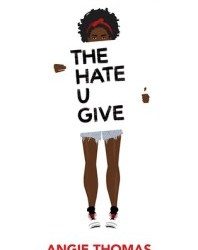

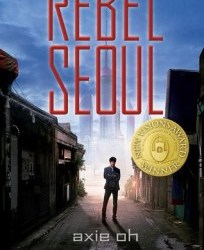



The close of the year is fast approaching, and that means it’s time for Audrey to look back and pick her favorite 2017 YA releases. There were so many amazing books this year, and here are the ones at the top of her list. What were your favorites this year?
The Hate U Give by Angie Thomas Balzer + Bray || Group Discussion
Sixteen-year-old Starr Carter moves between two worlds: the poor neighborhood where she lives and the fancy suburban prep school she attends. The uneasy balance between these worlds is shattered when Starr witnesses the fatal shooting of her childhood best friend, Khalil, at the hands of a police officer. Khalil was unarmed.
Soon afterward, Khalil’s death is a national headline. Some are calling him a thug, maybe even a drug dealer and a gangbanger. Starr’s best friend at school suggests he may have had it coming. When it becomes clear the police have little interest in investigating the incident, protesters take to the streets and Starr’s neighborhood becomes a war zone. What everyone wants to know is: What really went down that night? And the only person alive who can answer that is Starr.
But what Starr does—or does not—say could destroy her community. It could also endanger her life.
#NotYourPrincess: Voices of Native American Women edited by Lisa Charleyboy and MaryBeth Leatherdale Annick Press || Group Discussion
Whether looking back to a troubled past or welcoming a hopeful future, the powerful voices of Indigenous girls and women across North America resound in this book. In the same visual style as the bestselling Dreaming in Indian, #NotYourPrincess presents an eclectic collection of poems, essays, interviews, and art that combine to express the experience of being a Native woman. Stories of abuse, intergenerational trauma, and stereotyping are countered by the voices of passionate women demanding change and realizing their dreams. Sometimes outraged, often reflective, but always strong, the women in this book will give teen readers insight into the lives of women who, for so long, have had their history hidden and whose modern lives have been virtually invisible.
Rebel Seoul by Axie Oh Tu Books || Review
After a great war, the East Pacific is in ruins. In brutal Neo Seoul, where status comes from success in combat, ex-gang member Lee Jaewon is a talented pilot rising in the ranks of the academy. Abandoned as a kid in the slums of Old Seoul by his rebel father, Jaewon desires only to escape his past and prove himself a loyal soldier of the Neo State.
When Jaewon is recruited into the most lucrative weapons development division in Neo Seoul, he is eager to claim his best shot at military glory. But the mission becomes more complicated when he meets Tera, a test subject in the government’s supersoldier project. Tera was trained for one purpose: to pilot one of the lethal God Machines, massive robots for a never-ending war.
With secret orders to report on Tera, Jaewon becomes Tera’s partner, earning her reluctant respect. But as respect turns to love, Jaewon begins to question his loyalty to an oppressive regime that creates weapons out of humans. As the project prepares to go public amidst rumors of a rebellion, Jaewon must decide where he stands—as a soldier of the Neo State, or a rebel of the people.
Pacific Rim meets Korean action dramas in this mind-blowing, New Visions Award-winning science fiction debut.
Want by Cindy Pon Simon Pulse || Group Discussion
Jason Zhou survives in a divided society where the elite use their wealth to buy longer lives. The rich wear special suits, protecting them from the pollution and viruses that plague the city, while those without suffer illness and early deaths. Frustrated by his city’s corruption and still grieving the loss of his mother who died as a result of it, Zhou is determined to change things, no matter the cost.
With the help of his friends, Zhou infiltrates the lives of the wealthy in hopes of destroying the international Jin Corporation from within. Jin Corp not only manufactures the special suits the rich rely on, but they may also be manufacturing the pollution that makes them necessary.
Yet the deeper Zhou delves into this new world of excess and wealth, the more muddled his plans become. And against his better judgment, Zhou finds himself falling for Daiyu, the daughter of Jin Corp’s CEO. Can Zhou save his city without compromising who he is, or destroying his own heart?
When Dimple Met Rishi by Sandhya Menon Simon Pulse || Group Discussion
A laugh-out-loud, heartfelt YA romantic comedy, told in alternating perspectives, about two Indian-American teens whose parents have arranged for them to be married.
Dimple Shah has it all figured out. With graduation behind her, she’s more than ready for a break from her family, from Mamma’s inexplicable obsession with her finding the “Ideal Indian Husband.” Ugh. Dimple knows they must respect her principles on some level, though. If they truly believed she needed a husband right now, they wouldn’t have paid for her to attend a summer program for aspiring web developers…right?
Rishi Patel is a hopeless romantic. So when his parents tell him that his future wife will be attending the same summer program as him—wherein he’ll have to woo her—he’s totally on board. Because as silly as it sounds to most people in his life, Rishi wants to be arranged, believes in the power of tradition, stability, and being a part of something much bigger than himself.
The Shahs and Patels didn’t mean to start turning the wheels on this “suggested arrangement” so early in their children’s lives, but when they noticed them both gravitate toward the same summer program, they figured, Why not?
Dimple and Rishi may think they have each other figured out. But when opposites clash, love works hard to prove itself in the most unexpected ways.
Wild Beauty by Anna-Marie McLemore Feiwel & Friends || Review
Love grows such strange things.
For nearly a century, the Nomeolvides women have tended the grounds of La Pradera, the lush estate gardens that enchant guests from around the world. They’ve also hidden a tragic legacy: if they fall in love too deeply, their lovers vanish. But then, after generations of vanishings, a strange boy appears in the gardens.
The boy is a mystery to Estrella, the Nomeolvides girl who finds him, and to her family, but he’s even more a mystery to himself; he knows nothing more about who he is or where he came from than his first name. As Estrella tries to help Fel piece together his unknown past, La Pradera leads them to secrets as dangerous as they are magical in this stunning exploration of love, loss, and family.
#WeNeedDiverseBooks#the hate u give#NotYourPrincess#rebel seoul#want#when dimple met rishi#wild beauty#young adult books
63 notes
·
View notes
Text
Why Capitalism Creates Pointless Jobs
It’s as if someone were out there making up pointless jobs just for the sake of keeping us all working.
By David Graeber
In the year 1930, John Maynard Keynes predicted that technology would have advanced sufficiently by century’s end that countries like Great Britain or the United States would achieve a 15-hour work week. There’s every reason to believe he was right. In technological terms, we are quite capable of this. And yet it didn’t happen. Instead, technology has been marshaled, if anything, to figure out ways to make us all work more. In order to achieve this, jobs have had to be created that are, effectively, pointless. Huge swathes of people, in Europe and North America in particular, spend their entire working lives performing tasks they secretly believe do not really need to be performed. The moral and spiritual damage that comes from this situation is profound. It is a scar across our collective soul. Yet virtually no one talks about it.
Why did Keynes’ promised utopia – still being eagerly awaited in the ‘60s – never materialise? The standard line today is that he didn’t figure in the massive increase in consumerism. Given the choice between less hours and more toys and pleasures, we’ve collectively chosen the latter. This presents a nice morality tale, but even a moment’s reflection shows it can’t really be true. Yes, we have witnessed the creation of an endless variety of new jobs and industries since the ‘20s, but very few have anything to do with the production and distribution of sushi, iPhones, or fancy sneakers.
So what are these new jobs, precisely? A recent report comparing employment in the US between 1910 and 2000 gives us a clear picture (and I note, one pretty much exactly echoed in the UK). Over the course of the last century, the number of workers employed as domestic servants, in industry, and in the farm sector has collapsed dramatically. At the same time, “professional, managerial, clerical, sales, and service workers” tripled, growing “from one-quarter to three-quarters of total employment.” In other words, productive jobs have, just as predicted, been largely automated away (even if you count industrial workers globally, including the toiling masses in India and China, such workers are still not nearly so large a percentage of the world population as they used to be).
But rather than allowing a massive reduction of working hours to free the world’s population to pursue their own projects, pleasures, visions, and ideas, we have seen the ballooning not even so much of the “service” sector as of the administrative sector, up to and including the creation of whole new industries like financial services or telemarketing, or the unprecedented expansion of sectors like corporate law, academic and health administration, human resources, and public relations. And these numbers do not even reflect on all those people whose job is to provide administrative, technical, or security support for these industries, or for that matter the whole host of ancillary industries (dog-washers, all-night pizza deliverymen) that only exist because everyone else is spending so much of their time working in all the other ones.
These are what I propose to call “bullshit jobs.”
It’s as if someone were out there making up pointless jobs just for the sake of keeping us all working. And here, precisely, lies the mystery. In capitalism, this is exactly what is not supposed to happen. Sure, in the old inefficient socialist states like the Soviet Union, where employment was considered both a right and a sacred duty, the system made up as many jobs as they had to (this is why in Soviet department stores it took three clerks to sell a piece of meat). But, of course, this is the very sort of problem market competition is supposed to fix. According to economic theory, at least, the last thing a profit-seeking firm is going to do is shell out money to workers they don’t really need to employ. Still, somehow, it happens.
While corporations may engage in ruthless downsizing, the layoffs and speed-ups invariably fall on that class of people who are actually making, moving, fixing and maintaining things; through some strange alchemy no one can quite explain, the number of salaried paper-pushers ultimately seems to expand, and more and more employees find themselves, not unlike Soviet workers actually, working 40 or even 50 hour weeks on paper, but effectively working 15 hours just as Keynes predicted, since the rest of their time is spent organising or attending motivational seminars, updating their facebook profiles or downloading TV box-sets.
The answer clearly isn’t economic: it’s moral and political. The ruling class has figured out that a happy and productive population with free time on their hands is a mortal danger (think of what started to happen when this even began to be approximated in the ‘60s). And, on the other hand, the feeling that work is a moral value in itself, and that anyone not willing to submit themselves to some kind of intense work discipline for most of their waking hours deserves nothing, is extraordinarily convenient for them.
Once, when contemplating the apparently endless growth of administrative responsibilities in British academic departments, I came up with one possible vision of hell. Hell is a collection of individuals who are spending the bulk of their time working on a task they don’t like and are not especially good at. Say they were hired because they were excellent cabinet-makers, and then discover they are expected to spend a great deal of their time frying fish. Neither does the task really need to be done – at least, there’s only a very limited number of fish that need to be fried. Yet somehow, they all become so obsessed with resentment at the thought that some of their co-workers might be spending more time making cabinets, and not doing their fair share of the fish-frying responsibilities, that before long there’s endless piles of useless badly cooked fish piling up all over the workshop and it’s all that anyone really does.
I think this is actually a pretty accurate description of the moral dynamics of our own economy.
*
Now, I realise any such argument is going to run into immediate objections: “who are you to say what jobs are really ‘necessary’? What’s necessary anyway? You’re an anthropology professor, what’s the ‘need’ for that?” (And indeed a lot of tabloid readers would take the existence of my job as the very definition of wasteful social expenditure.) And on one level, this is obviously true. There can be no objective measure of social value.
I would not presume to tell someone who is convinced they are making a meaningful contribution to the world that, really, they are not. But what about those people who are themselves convinced their jobs are meaningless? Not long ago I got back in touch with a school friend who I hadn’t seen since I was 12. I was amazed to discover that in the interim, he had become first a poet, then the front man in an indie rock band. I’d heard some of his songs on the radio having no idea the singer was someone I actually knew. He was obviously brilliant, innovative, and his work had unquestionably brightened and improved the lives of people all over the world. Yet, after a couple of unsuccessful albums, he’d lost his contract, and plagued with debts and a newborn daughter, ended up, as he put it, “taking the default choice of so many directionless folk: law school.” Now he’s a corporate lawyer working in a prominent New York firm. He was the first to admit that his job was utterly meaningless, contributed nothing to the world, and, in his own estimation, should not really exist.
There’s a lot of questions one could ask here, starting with, what does it say about our society that it seems to generate an extremely limited demand for talented poet-musicians, but an apparently infinite demand for specialists in corporate law? (Answer: if 1% of the population controls most of the disposable wealth, what we call “the market” reflects what they think is useful or important, not anybody else.) But even more, it shows that most people in these jobs are ultimately aware of it. In fact, I’m not sure I’ve ever met a corporate lawyer who didn’t think their job was bullshit. The same goes for almost all the new industries outlined above. There is a whole class of salaried professionals that, should you meet them at parties and admit that you do something that might be considered interesting (an anthropologist, for example), will want to avoid even discussing their line of work entirely. Give them a few drinks, and they will launch into tirades about how pointless and stupid their job really is.
This is a profound psychological violence here. How can one even begin to speak of dignity in labour when one secretly feels one’s job should not exist? How can it not create a sense of deep rage and resentment. Yet it is the peculiar genius of our society that its rulers have figured out a way, as in the case of the fish-fryers, to ensure that rage is directed precisely against those who actually do get to do meaningful work. For instance: in our society, there seems a general rule that, the more obviously one’s work benefits other people, the less one is likely to be paid for it. Again, an objective measure is hard to find, but one easy way to get a sense is to ask: what would happen were this entire class of people to simply disappear? Say what you like about nurses, garbage collectors, or mechanics, it’s obvious that were they to vanish in a puff of smoke, the results would be immediate and catastrophic. A world without teachers or dock-workers would soon be in trouble, and even one without science fiction writers or ska musicians would clearly be a lesser place. It’s not entirely clear how humanity would suffer were all private equity CEOs, lobbyists, PR researchers, actuaries, telemarketers, bailiffs or legal consultants to similarly vanish. (Many suspect it might markedly improve.) Yet apart from a handful of well-touted exceptions (doctors), the rule holds surprisingly well.
Even more perverse, there seems to be a broad sense that this is the way things should be. This is one of the secret strengths of right-wing populism. You can see it when tabloids whip up resentment against tube workers for paralysing London during contract disputes: the very fact that tube workers can paralyse London shows that their work is actually necessary, but this seems to be precisely what annoys people. It’s even clearer in the US, where Republicans have had remarkable success mobilizing resentment against school teachers, or auto workers (and not, significantly, against the school administrators or auto industry managers who actually cause the problems) for their supposedly bloated wages and benefits. It’s as if they are being told “but you get to teach children! Or make cars! You get to have real jobs! And on top of that you have the nerve to also expect middle-class pensions and health care?”
If someone had designed a work regime perfectly suited to maintaining the power of finance capital, it’s hard to see how they could have done a better job. Real, productive workers are relentlessly squeezed and exploited. The remainder are divided between a terrorised stratum of the – universally reviled – unemployed and a larger stratum who are basically paid to do nothing, in positions designed to make them identify with the perspectives and sensibilities of the ruling class (managers, administrators, etc) – and particularly its financial avatars – but, at the same time, foster a simmering resentment against anyone whose work has clear and undeniable social value. Clearly, the system was never consciously designed. It emerged from almost a century of trial and error. But it is the only explanation for why, despite our technological capacities, we are not all working 3-4 hour days.
2 notes
·
View notes
Text
Read It Should Have Been You, a Short Story on the Future of Death
Read It Should Have Been You, a Short Story on the Future of Death https://ift.tt/2yJcfcp

Image: Kundra/Shutterstock
[Beginning Log File 0289]
Fuck you.
No, seriously, fuck you.
My collection site hurts particularly bad today and I’m cranky, but I need to focus on you. You, the one with the permanent bag under your left eye after you let your dumbass cousin hack your car and turn the ADT off. Your face slammed into the console, which turned your orbital bone into an assortment of mismatched, razor-sharp puzzle pieces that tried to find homes in the gooey surface of your eye, but it was Shakyra who flew through the windshield and wetly slid down the hood until she plopped onto the road. The ambulance had already been deployed the moment she crashed into the car in front of you two, but when it arrived five minutes later, its sirens weren’t even on. It eased to a stop and two paramedics casually slid from the front seat. The road sensors had already told them she was dead.
You were spared from the full visual effect of her broken, bleeding body because you’d gone temporarily blind in that left eye. But you knew. The paramedics knew. The onlookers, who cruised by in their own self-driving cars, never stopping, never slowing down—they knew, too. But you weren’t thinking of Shakyra as stupid then, not yet. All you were thinking as the paramedics guided you onto the stretcher was, “No.”
Shit, I hate thinking about that. Fuck, fuck, fuck—
[Log file recording terminated. Progress saved.]
…Shit. Calm down. They’re listening, of course they are. They always are.
But back to you. That accident is where my story begins.
When the blood trade started, you and Shakyra just shook your heads and laughed. “White people,” you agreed. But that sure as hell didn’t stop you from slipping into some seedy pit of a plasma center when you were finally fired from your job at Meijer—a particularly bad migraine had you vomiting all over the produce section like some horrible parody of The Exorcist.
You remember The Exorcist, right? I’ve become obsessed with artifacts from before the Great Elevation: movies, TV, books, you name it, I got it, even Dracula, which oddly was a bitch to find. When I can’t quite grasp onto you, I grasp onto those movies. They remind me that there are much worse fates than death…Not that I really need reminding, anymore.
“Feeling better?” Katya asks me, a placid smile on her bright face.
“Yes,” I say, because there’s nothing else she wants to hear. I settle back down on my bed and turn to stare out at the cloudless gray sky. The little virtual assistant console on the nightstand flickers blue three times before the light goes out. Not dead, just resting.
“That’s good. Repressing your feelings isn’t good for stress levels…a little emotional release here and there can be really helpful.” She gives me the practiced stare of a fed-up, underpaid RN, though her immense wealth is why she’s here at all. “Just don’t overdo it, okay?”
Warning heard loud and clear. “Okay.”
Katya Belaya is 115 years old. She’s worked as a hematology nurse almost as long as I’ve been alive, at thirty-four. That was when research around blood therapy really kicked off.
She doesn’t talk about her life before the Great Elevation much, but I’ve overheard bits and pieces during the chaos of shift changes—she was retired, living quite well on the inheritance from her dear old husband’s death, but then the advertisements started coming out in full force, promising eternal youth for the right price. And this fool actually believed it; she’s been supervising dumbasses like me ever since. Right now, her bland smile seems to say, “Who’s the fool now?”
After just ten years of treatments, she looks young enough to be my mother.
This is the story of how you overcame death: You signed a contract.
You’d heard the rumors, of course. Everyone had: Rich old people thought they could obtain the key to immortality by getting regular infusions of blood from young, healthy people…sorry, young, healthy, poor people. Because why in the fuck would you help someone like David Rockefeller live even longer unless it was the difference between sleeping in your bed for another month or living in your car? So yes, you overcame death because you were too poor to die. The moment those bullshit treatments turned out not to be so bullshit after all, the coveted “good death” became a luxury like it never had before.
You are the perpetual motion device keeping that luxury conveniently available to people like Katya. You spend a lot of time in these hospital rooms, these beds. They’re much comfier than anything you could ever afford on your own, let’s be clear. And the staff is just always listening and watching and smiling because they want you to be healthy, pet.
I mean, what the fuck good is your blood if you—sorry, they—let your body go to shit? Kale for everyone. Hurray.
There will be raised bumps amid the corded muscles of your upper arms—one for each side. They’re as big around as a penny, with the mass of a glass marble embedded under the surface. You’ll scratch at them sometimes, when no one’s looking—never in the hospital, though, that would be a level of stupid even you won’t begin to contemplate—but they do not move or compress.
If you were to take, say, a knife—do NOT do this, but just say one day you did—and make a small, clean cut across that marble of tissue, you would be engulfed by a pain so relentless that you’d immediately black out. When you’d wake up, any evidence of your crimes would be gone, save for a pale scar that’d vanish within a couple days.
Soon, you’ll enter your go-to blood center looking to score enough for rent and your car—the demand has gone up. Three times the money. And when the nurse slaps a Band-Aid across your inner arm and tells you you’re good to go, a man in a doctor’s coat who you suddenly, somehow, know is not a doctor will appear in the slim gap between the privacy curtains and ask you to take a survey. The nurse will slip away, as light and soundless as a sunbeam, and the not-doctor will slowly ease into the chair she’s just vacated.
You will remember him well, so well, even after decades pass: the bald head with just a hint of brown fuzz, long fingers and wide palms with bulging veins, beady gray eyes tracking your every movement behind basic black frames. The frames are what give him away—they’re Mykita, which are expensive as fuck. Your girlfriend at the time is (was) crazy about everything fashion. You’ll scoff at the thought of remembering this, and vow to get payback by forcing her to sit through a Hell’s Kitchen marathon.
The not-doctor has other plans. “When was the last time you lost someone you cared about?”
Many faces will flit through your mind as an unwelcome wave of longing seeps into your chest. But although she wasn’t the last, she was the most: Shakyra. You watched her die. You didn’t stop her. But you could’ve. You—stupid, stupid, stupid you—didn’t. Why? You won’t know. You never will.
The not-doctor will see something in your eyes, something he approves of. He’ll lean forward, his legs planted shoulder length apart, and brace his forearms on his jean-covered thighs. Stare straight at you. Clasp his hands together, solemn. “What would it be worth to you,” he’ll murmur, voice thick with faux empathy, “to never have to experience that pain again?”
And that…your poor, sick bastard, that’s all it’ll take. He’ll explain, using way too much medical jargon, about what he wants to do—what he wants you to do. And you’ll sign. Even though, deep down, you know eliminating programmed cell death wouldn’t have saved Shakyra, grief isn’t sensible, so you’ll sign. The nurse will reappear with a twin pair of syringes before you’ve even finished the last curlicue on your signature.
“Everyone will have access to this,” the not-doctor assures you. “And for every person you refer, your payments will quadruple.”
But your girlfriend has (had) Type 1 diabetes: unfit.
Your mother? Hypertension and asthma. Ask her to lose some weight first.
Father? Lung cancer. Brother? Bipolar. You’re the dumbass with the permanently puffy eye, but apparently that’s not a genetic flaw, just a common-sense one. You’ll receive marbles in your arms that permanently stop the passage of time, as far as your DNA is concerned, all so you can spend the rest of your immortal existence “donating” blood to people who want to be buried as young, beautiful corpses.
Confused? Yup, it’s true: Katya, the not-doctor, and all the rest of the recipients…they don’t have the marbles.
You will sustain them for as long as they want to live, then stand watch when they don’t.
Today is Katya’s Death Day. She is 137 years old.
She has decided she’s seen everything the world has to offer, so it’s time. She picked out her coffin—sleek mahogany with golden accents—herself. She’s been without blood transfusions for a week now. The attending doctor says it will be any minute.
They don’t say “death” anymore—it’s the “next elevation.” Half her family, just as bright-faced and virile as she was, are drunk off their asses while she lies in the coffin, her breathing slowing, slowing, slowing…a long pause, during which everyone and everything suddenly sobers, stops…and then a wet rattle from her throat shatters the moment and the merriment continues.
I hover nearby; once she’s finally dead, I’ll have a new “nurse,” but who the hell cares. This precious thing, death, is something I likely will never experience. I dream of it, ache for it. I’m monitored too closely to down a container of bleach, or jump off a roof. My knives disappeared from my kitchen decades ago; my food arrives pre-cut. Everyone I knew who was too “unfit” for immortality is long gone. Naturally, there was no fanfare for them. Disability and illness are for the poors, you know. Should’ve made more money, and then they could’ve died in health instead of sickness. Should’ve taken better care of themselves.
You know, like I do.
Katya’s breathing stops again, for long enough that the DJ lowers the music until it’s just a faint pulse in my eardrums—like a heartbeat.
I stare at her softly rounded, rosy face; she’s wearing foundation and concealer under her eyes for her nonexistent flaws and diamond earrings that glint under the light of the crystal chandelier directly above us. She’s beautiful, and I want to drive a stake through her rotten heart.
The doctor leans over and presses her index and forefinger against Katya’s throat. After another pause, she proclaims, “Official time of death: 21:27.”
A chorus of applause and joyful shouts fills the room. I trail my fingers over my upper arm, not even feeling the sting of my nails digging into the flesh, reflexively. I lift my other arm and wake up my smartwatch with a scan of my retina.
“Log file 1076,” I whisper. “Those books were really fucking wrong about vampires.”
I’m being harsh, I know. I’m sorry. This…this is a lot.
Please, before you walk into that donation center one last time…think of Shakyra. Think of her broken body, splayed across the ground. The indifferent stares of onlookers who felt she’d brought it on herself.
Imagine what her last few seconds of awareness were like. Did pain rip through her like those ragged shards of glass? Did she sense her lungs filling with blood and phlegm? Did she choke? Gasp?
Imagine it. And know that, even though it’ll forever haunt us both, I wish it’d been you.
But I’ve gotta go: Katya’s replacement is waiting, and I bet he hates having to wait.
Sydnee Thompson is a writer and editor who’s unabashedly obsessed with all things death, especially when it comes to her speculative fiction, which has also appeared in publications such as Fiyah Lit Magazine and Fireside Magazine. You can stalk her on Twitter @SydMT or visit her website, shadesofsydnee.com.
via Gizmodo https://gizmodo.com October 31, 2018 at 06:45PM
0 notes